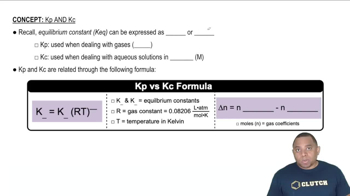Here are the essential concepts you must grasp in order to answer the question correctly.
Equilibrium Constant (Kc and Kp)
The equilibrium constant (Kc) is a ratio of the concentrations of products to reactants at equilibrium, raised to the power of their coefficients in the balanced equation. Kp is similar but uses partial pressures instead of concentrations. For the reaction CH4(g) + H2O(g) ⇌ CO(g) + 3H2(g), Kc and Kp can be calculated using the molar concentrations or partial pressures of the gases involved, reflecting the extent of the reaction at equilibrium.
Recommended video:
Stoichiometry
Stoichiometry involves the quantitative relationships between the amounts of reactants and products in a chemical reaction. In this case, the stoichiometric coefficients from the balanced equation indicate that one mole of CH4 reacts with one mole of H2O to produce one mole of CO and three moles of H2. Understanding stoichiometry is essential for calculating the concentrations or partial pressures needed to determine Kc and Kp.
Recommended video:
Gas Laws and Molar Volume
Gas laws describe the behavior of gases under various conditions of temperature and pressure. The ideal gas law (PV=nRT) relates pressure (P), volume (V), number of moles (n), the ideal gas constant (R), and temperature (T). In this problem, the volume of the gas collected (5.00 L) and the mass of each component allow for the calculation of moles, which are necessary for determining concentrations or partial pressures for the equilibrium constant calculations.
Recommended video:
The Ideal Gas Law: Molar Mass
 Verified step by step guidance
Verified step by step guidance

